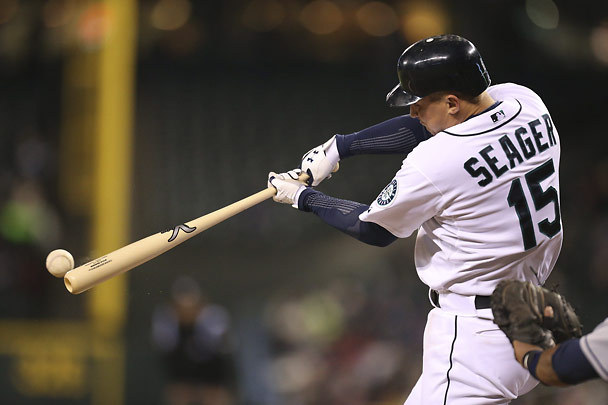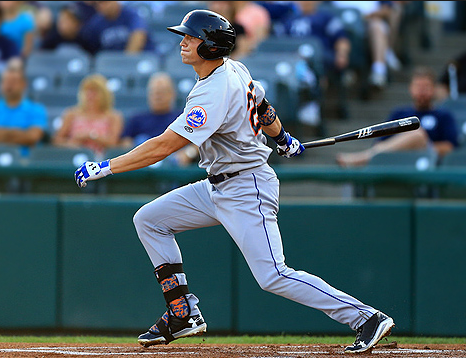
Kyle Seager signed a $100 million dollar 7-year extension with the Mariners on Monday. The deal absorbs his final two years of salary arbitration and tacks on five more years and a team option, keeping him in a Mariners uniform until 2022 (his 34th birthday).
Seager is something of an oddity. He was drafted out of the University of North Carolina in 2009 at 22 and was never a highly ranked prospect. He has nevertheless established himself as a power threat at the hot corner, albeit a modest one — dampened by Safeco Field. He is also the first player to sign a nine-figure deal without at least one .800 OPS season.
Younger exceptional players like Mike Trout, Giancarlo Stanton, Evan Longoria, and (yes) Ryan Braun, and even somewhat less exceptional players like Seager are increasingly signing extensions that swallow up their prime years, while on the other end of the “team control” spectrum you have older but still productive players getting qualifying offers. The combined effect of this pinching severely attenuates the free agency talent pool at its margins.
In the past, players like Seager were more likely to hold out until their six year team commitment expired, entering free agency with their prime still in the offing … these days that doesn’t happen. From the player’s standpoint the incentive is twofold, they’d prefer to have the money now rather than later (a bird in hand), and they’re lured by the promise of long term security, mitigating the risk of injury or decline. Most players like Seager would be foolish not to sign these extensions. If you look at dollars per WAR it is also precisely in these types (and even pre-arbitration) players that teams are relying on for wins.
Seager is sort of a template on how to maximize team control over a player’s prime – eerily reminiscent of reserve clause “fruits of development” labor arguments. You draft a promising older player out of college, delay his start time, let him play out his first couple of pre-arbitration years at the major league level, and then, provided he performs at a high level, you sign him to a “fan friendly” extension absorbing his prime production seasons.
One benefit of these retention tactics is that teams get to keep homegrown stars — which is good for the fans, but a disemboweled free agent talent pool will eventually bring salaries down — which is good for MLB. Now it’s usually at this point in the discussion when I get some push-back. In spite of all the wasted sunken dollars, free agent compensation has not decreased. Matt Swartz in The Hardball Times, looked at Dollars/WAR in 2013 and it increased slightly.
I find this almost as mind boggling as the Pablo Sandoval contract. I mean I know pandas are endangered but five years and $95 million?
So what gives? Shin-Soo Choo got $18 million last year for .2 WAR, then there’s B.J. Upton, Brian McCann, Josh Hamilton … the “unmitigated contract disaster” list gets longer every year. Why do teams continue to spend lavishly on free agents? Why would the Red Sox spend $183 million on two free agents a year removed from a purge that saw them unload a slew of cumbersome contracts? MLB’s unprecedented media cash flow may have something to do with it, but still.
It could also be that teams still believe in having a strong mix of veterans and youth and that the Red Sox simply feel they had the wrong veteran presence before (Hanley in left? Really?). Perhaps, like the Mets and Michael Cuddyer, they feel having the right veteran influence can mean all the difference. Even so, I seriously doubt a savvy organization like the Red Sox doesn’t understand the inherent risks in giving out long FA contracts given the data. It’s almost like some teams impulsively throw money around just for the heck of it … perhaps it’s a “use it or lose it” dynamic with spending allocations. Sadly the Mets are not in a position to take these kinds of risks, by necessity they are betting on their own generation of young controllable stars, and that’s really where the smart money is.
Players like Michael Conforto could (contractually) take a very similar path to Kyle Seager. Like Seager, Conforto was drafted as a college player and will probably not see his major league clock start for another couple of years. Conforto would then be around 27 or 28 before the Mets are pressed into deciding whether to offer him a pre-arbitration extension which would give them control over him until around his 33rd birthday … right around the average point of decline. If he is still playing at a high level? You Q.O. him, bam, done.

The earliest Brandon Nimmo will see the major leagues is late in 2015 by which time he’ll be 22. If he proves to be all-star caliber then an extension would take him through his 30th birthday … not quite optimal but between an option year and the Q.O. the Mets would still get him for most of his prime. People keep praising the Mets for being patient, but I wonder how much of this patience is an economic consideration orchestrated to ensure control of players through their most valuable seasons.
Now Dilson Herrera was brought up at the age of 20, and, like Reyes, could see his clock run out during his prime … why? Your guess is as good as mine on that one. Maybe it was organizational need, or maybe they see Herrera as the sort of complimentary impact player who is worth the gamble. The Mets seem to be taking “a little of everything” approach. They have the long developing High School draftees as well as the fast track college players, they have players who have stepped on all the rungs as well as players who have skipped levels, they have phenoms and dark horses alike in their pitching ranks. The Mets minor leagues are an exercise in overkill … which is as it should be when you consider failure rates.
One thing is clear, there will be a point in the next few seasons when the Mets will be faced with some tough decisions on whether to extend a growing list of high performing youngsters. Between Matt Harvey, Jacob deGrom and Travis d’Arnaud, followed by Syndergaard, Nimmo and Conforto, it amounts to a $100 million (or more) extension being doled out every year or two starting at around 2016 … that’s an awful lot of spending from an organization that appears to have completely forgotten how that works.
It’s worrisome from a fan’s perspective … especially when you consider that the only thing worse than this recent stretch of losing would be to let all the fruits of our suffering walk away one by one. All we can do is hope Sandy Alderson has his $100 million dollar extension checkbook at the ready.















